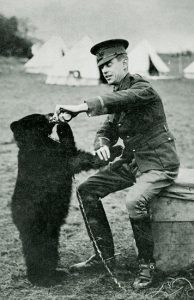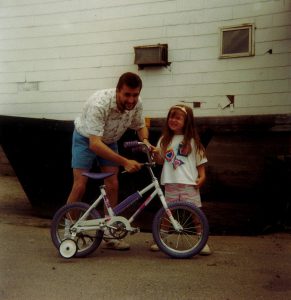I have a distinct memory of my dad picking me up from daycare and presenting me with two of the loveliest books I had ever seen: The World of Christopher Robin and The World of Pooh, by A.A. Milne. At the time, my dad was a member of Quality Paperback Book Club, a division of Book of the Month Club. Members were required to purchase a certain number of books each year. There was a monthly mailing, but members did not have to make a purchase each month. Quality paperbacks indeed – the books were large with many cream-colored pages, and my dad had gotten them with the intention of reading them to me. I was bursting with happiness.
I grew up reading and watching Winnie-the-Pooh (or Winnie-ther-Pooh); it’s almost as if this silly old bear is a family member. He was introduced to me as a child; I sought him out as I aged – my love is everlasting. Stuffed animals, journals, picture frames, clothing, and bookends with his likeness declared my allegiance. I purchased The Tao of Pooh (Hoff, 1983) and The Te of Piglet (Hoff, 1993) as a teenager, delighted that Pooh had followed me out of the children’s section of the bookstore.
When I had children of my own, I couldn’t wait to introduce them to the world Milne had created for his child. I waited until my oldest was at least 4 and began with The World of Christopher Robin. The whimsical plots and word pairings delighted his ears. We snuggled and giggled our way through.
 In 2015, the children’s book Finding Winnie by Lindsay Mattick came out, and my mom bought it for me, her adult daughter. It’s a story within a story: a mother tells her son a bedtime story about a man named Harry Colebourn who purchased a real, live American black bear in the summer of 1914.
In 2015, the children’s book Finding Winnie by Lindsay Mattick came out, and my mom bought it for me, her adult daughter. It’s a story within a story: a mother tells her son a bedtime story about a man named Harry Colebourn who purchased a real, live American black bear in the summer of 1914.
Harry befriends this animal and names her Winnipeg – Winnie for short. Harry brings Winnie overseas with him as he ships off to England as part of the Canadian Army Veterinary Corps during World War I.
Winnie lives in Harry’s tent during training, but Harry does not bring her into battle. He instead donates her to the London Zoo, and that is how Winnie becomes friends with the real-life Christopher Robin Milne. While we all know what that relationship led to, that is not where this story ends.
The grand reveal is that the author, Lindsay Mattick, is actually Harry Colebourn’s great-granddaughter. This is illustrated with a family tree showing the author’s descent from Harry. In a style near and dear to our hearts here at NEHGS, the book changes from a picture book into what is called the Album. Real documents from Harry and Winnie’s lives are displayed, along with their photographs. There is an entry in Harry’s journal dated 24 August 1914 saying, “Bought bear $20.” A photo of Harry and soldiers with Winnie right in the middle is evidence of how extraordinary this bear actually was. Winnie’s file from the London Zoo shows that Winnie was donated 9 December 1914 and lived there until her death in 1934.
Real documents from Harry and Winnie’s lives are displayed, along with photos of Harry and Winnie.
This book is delightful for so many reasons. It is beautifully written and illustrated – it is the winner of the 2016 Caldecott Medal – and of course brings me so much joy due to my love of Winnie-the-Pooh. The true beauty lies in how it invites children seamlessly into a family’s story, a family’s history.
It uses a simple yet effective formula: tell the story + show the relationship. This is a wonderful template for those looking for a way to present family history to future generations. Tell your story in a clear and straightforward way. Try to remain focused on one topic. While many might not possess the talent of the book’s illustrator Sophie Blackall, you can turn to a relative or friend who does, use photos, or even use clip art. Collect a handful of documents and photos that show the real people and places from your story. Create a family tree or chart that explains how you are related.
My six-year-old loves Finding Winnie. He closely inspects the documents at the end of the book. The old photos intrigue him. Finding out that a story is true can be quite exciting. Finding Winnie resides on a shelf in one of my bookcases. But don’t you fret; my parents taught me how to share.
*
For those in the Boston area, be sure to check out the new exhibit at the Museum of Fine Art, “Winnie-the-Pooh: Exploring a Classic.” It runs until 6 January 2019.
Share this:

About Cécile Engeln
Cécile joined NEHGS with nearly ten years of editorial and project management experience in academic publishing. She has developed a variety of books, ranging from a guide to U.S. citizenship to graphic novels, and managed the production of complex foreign language programs. She graduated with a B.A. in English Literature and a minor in French from Andrews University in Michigan. She received her M.A. in Publishing and Writing from Emerson College.View all posts by Cécile Engeln →
